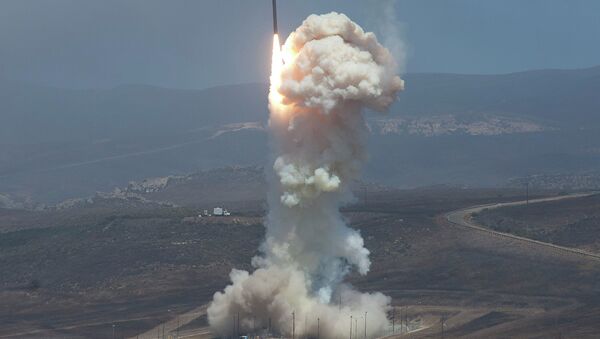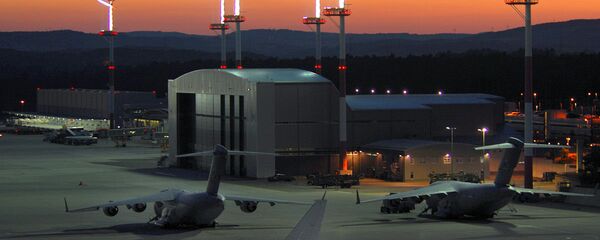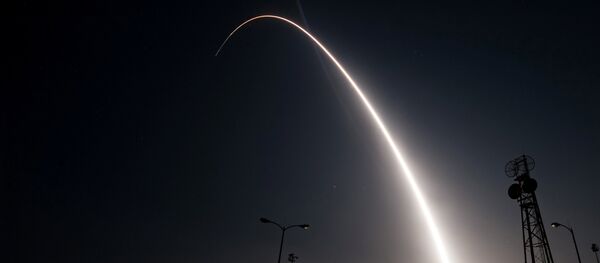On Tuesday, the US military tested its Ground-based Midcourse Defense System (GMD), the US Missile Defense Agency (MDA) reported.
During the tests, an ICBM-class target was launched from the Raegan Test Site in the Republic of the Marshall Islands. A ground-based intercepting missile was fired from Vandenberg Air Force Base in California. According to the statement, the target was hit and destroyed as a result of a "direct collision" by the interceptor’s exo-atmospheric kill vehicle.
The test marks the first time the GMD has been used against an ICBM-class target. All previous launches have been against intermediate-range ballistic missile targets.
"This system is vitally important to the defense of our homeland, and this test demonstrates that we have a capable, credible deterrent against a very real threat. I am incredibly proud of the warfighters who executed this test and who operate this system every day," according to MDA Director Vice Adm. Jim Syring.
The system operates in conjunction with a radio-radar station, including the Sea-Based X-band radar or the ground base PAVE PAWS station. The radar provides acquiring and tracking data of the target to the GMD. Then, a silo-based intercepting missile is launched. After the interceptor enters space the Exo-Atmospheric Kill Vehicle (EKV) separates from the boost vehicle, autonomously acquires the target and destroys it in a direct collision.
Destroying an ICBM in space is a major milestone in engineering terms. The Pentagon managed to complete an extremely technically difficult task to hit a tiny object in space at a distance of thousands of kilometers and at speed of up 10 kilometers per second.
At the same time, in terms of practical use, the situation is more complicated. The GMD was in development since the late-1990s and was deployed in 2004. Currently, 32 interceptors are deployed at Fort Greely, Alaska, and four missiles at Vandenberg Air Force Base. An additional eight interceptors are planned to be deployed by the end of the year. Of course, the system has never been used in combat.
In an interview with the Russian online newspaper Vzglyad, Col. Sergei Khatylev, former commander of the anti-aircraft missile forces of the Russian Air Force, said that more tests are needed to prove the capabilities of the GMD.
"It is premature to call this launch a major success. More tests are needed under different conditions. If there are some obstacles, including jamming or any other counteraction, the range and accuracy will be reduced twofold," Khatylev said.
"In several ways, this test was a $244 million dollar baby step, a baby step that took three years," Philip Coyle, former head of the Pentagon’s office of operational test and evaluation, told Defense News.
According to estimates, total costs of the GMD program are nearly $40 billion.
Moreover, the launch can also be seen in the context of its consequences for the strategic nuclear balance between Moscow and Washington.
The GMD is designed to repel nuclear attacks from such countries as Iran or North Korea. Its technology enables destroying a limited number of ageing types of single-block ICBMs. Initially, there was also a plan to develop an interceptor capable of hitting missile with multiple warheads, but the program was canceled in 2009 due to costs and technical problems.
"There is nothing new about this test. The US and Russia regularly carry out such launches. It is nothing specials," Lt. Gen. Aytech Bizhev, former deputy commander of the Russian Air Force, told Vzglyad.
According to Khatylev, Russian missiles, including the RS-24 Yars, use radio jamming and multiple warheads, which in theory would decrease the GMD efficiency.
Apparently, the test reflects Washington’s hardline stance towards North Korea. It came two days after another ballistic missile launch by Pyongyang.
Some experts suggest that it cannot be ruled out that Washington is examining the possibility of a preventive strike on North Korean, including considering ways to repel a counterattack.
According to Bizhev, one of the goals of the latest test was to disperse concerns in the US establishment and prove that the US is capable to response in the event of an attack.
"The Americans are pragmatic. When tensions are on the rise somewhere in the world they push for upgrading their technical capabilities. Now, they will capitalize on this issue in Senate and ask for more funds for missile defense," Khatylev said.
Never miss a story again — sign up to our Telegram channel and we'll keep you up to speed!







